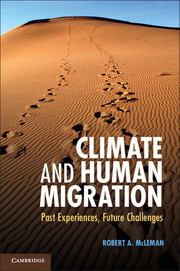Book contents
- Frontmatter
- Dedication
- Contents
- List of Figures
- List of Tables
- Preface
- Acknowledgments
- 1 An Introduction to the Study of Climate and Migration
- 2 Why People Migrate
- 3 Migration in the Context of Vulnerability and Adaptation to Climatic Variability and Change
- 4 Extreme Weather Events and Migration
- 5 River Valley Flooding and Migration
- 6 Drought and Its Influence on Migration
- 7 Mean Sea Level Rise and Its Implications for Migration and Migration Policy
- 8 Emergent Issues in Climate and Migration Research
- Annex Estimates of Global Population Exposed to Tropical Cyclones
- References
- Index
4 - Extreme Weather Events and Migration
Published online by Cambridge University Press: 05 December 2013
- Frontmatter
- Dedication
- Contents
- List of Figures
- List of Tables
- Preface
- Acknowledgments
- 1 An Introduction to the Study of Climate and Migration
- 2 Why People Migrate
- 3 Migration in the Context of Vulnerability and Adaptation to Climatic Variability and Change
- 4 Extreme Weather Events and Migration
- 5 River Valley Flooding and Migration
- 6 Drought and Its Influence on Migration
- 7 Mean Sea Level Rise and Its Implications for Migration and Migration Policy
- 8 Emergent Issues in Climate and Migration Research
- Annex Estimates of Global Population Exposed to Tropical Cyclones
- References
- Index
Summary
Introduction
Extreme weather events comprise a range of phenomena, including tropical cyclonic storms (hurricanes, cyclones, and typhoons), tornadoes, other types of intense storm events (e.g. windstorms, hailstorms, blizzards, thunderstorms), unusually heavy precipitation associated with monsoons, and periods of extreme heat or cold. Extreme storm events are typically accompanied by strong winds and large amounts of precipitation, meaning that they may also lead to flooding, mudslides, storm surges, and other dangerous impacts. Especially severe storms can cause destruction of houses and businesses; damage critical infrastructure such as water supplies, transportation networks, and electrical utilities; disrupt livelihoods; cause large numbers of injuries or loss of life; and lead to displacement and out-migration from the affected area. Wealthy and poor populations alike are at risk of experiencing loss, harm, and displacement as a consequence of extreme weather events, although research reviewed in this chapter shows that it is the poor, the physically weak, and the socially marginalized or isolated who are often most vulnerable.
As suggested in the MESA function in the previous chapter, the potential for migration increases with the severity of the extreme event and with the sensitivity of the exposed population, but decreases when the exposed population has strong adaptive capacity. In regions where extreme weather events are already common and expected to remain so, such as the southern United States, the Caribbean, and coastal south and southeast Asia, human population numbers are increasing rapidly. Population growth in these regions has often been accompanied by removal or degradation of natural features that act as buffers to storm impacts, such as coral reefs, barrier islands, coastal mangroves, wetlands, and upland forest cover. The combined effects of climate change, population growth, and landscape modification suggest a future trajectory of growing human vulnerability to extreme events and increased potential for associated migration. Actual future outcomes in terms of migration will depend heavily on the continued development of proactive measures to reduce exposure (through such things as emergency preparedness, improved advance warning and communications systems, and protection of natural buffers) and improving institutional and household-level capacity to respond effectively to these events when they occur (through, for example, improved housing and infrastructure standards, disaster recovery assistance, and greater overall socioeconomic well-being).
- Type
- Chapter
- Information
- Climate and Human MigrationPast Experiences, Future Challenges, pp. 77 - 110Publisher: Cambridge University PressPrint publication year: 2013



